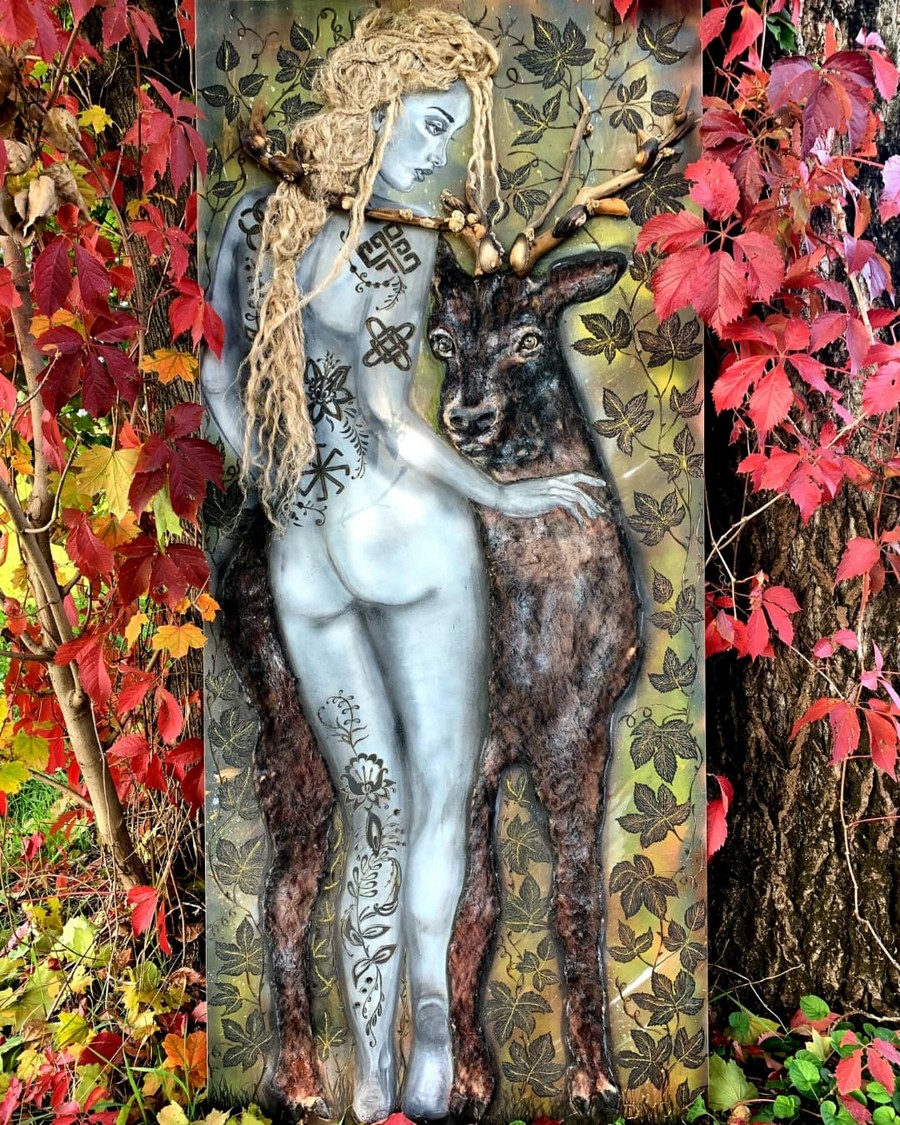Deer
In Greco-Roman tradition, the deer is associated with the goddess
Artemis (Diana). This image was inspired by Acteon and Artemis
myth. Actaeon, Artemis’s hunting companion, once saw her naked
while bathing in a pond. Furious, the goddess immediately turned
him into a deer. This scene has also been represented by Tiziano in
“Artemis and Actaeon” (1556 - 1559).
Old Mayas were called ‘Ah-Maya’ : ‘people of the Deer’. The animal was considered the main, great tribal ancestor and, as a consequence, a sacred animal. Among the Celts, the deer used to symbolise the Sun, fertility and vigour as well as dignity, masculinity and speed. He was also deemed to mediate between the divine and the earthly worlds. In Norse mythology, drawings picture four deers tearing leaves off Yggdrasil, the tree of the world. In Christian symbolism, the deer evokes enthusiasm and religious fervour.
In alchemy, deers and unicorns mirror Mercury’s double nature. Among slaves, the deer was an embodiment of the ancestors. The myth tells that it performed various miracles, among which it talked with a human voice. In old poems, deers bring the deads’ souls into the Afterlife as much as the heavenly horses used to do. It has always been considered a royal animal: it rules on all horned animals. Because of the resemblance between its horns and tree branches, the deer is also affiliated with the tree of life.
Symbols
"Rozhanitsa" - it embodies family bonds, ancestors and pregnancy.
"Lada Star" - honour, faith, justice, love for freedom. The sign of the protectress of love and family, a guide for seeking wisdom to future generations; it enacts a connection with the ancestors. It is also believed to protect motherhood.
"Svadebnik" - A decorated sign granting protections to brides and grooms. It draws good luck and happy moments. It represents the wish to constitute a homely hearth.
"Ladinets' is a matched symbol, a mirror image of the male
Kolyadnik’s.
It embodies harmony between two principles. It provides protection to the feminine principle of Chaos, ready to embrace a peaceful process of creation. These two figures represent fire as well as the full moon.
The charm is bound to protect and guide women who practise mysticism during their journey in the spiritual world. It’s a shield from fake knowledge, it reveals consciousness. The owner can find its forgotten, deep female energy through it.
What I used
I collected shells and branches on the Baltic coast; they are talismans among Latvians. The sea’s creativity stops ashore to inspire people.
Cattail
In Baltic cultures, cattail is variously used in cooking, medicine and ornamental arts. Its fluff is used to stuff pillows, make fabric, art pottery, as a natural water filter or fuel.
Hydraulic hemp (tow)
It is made of hemp and linen fibres. In the old times, this material was largely employed for clothes and household tools and materials.
The frame of the painting is made of burnt spruce as a tribute to the ancient Japanese technique.
Old Mayas were called ‘Ah-Maya’ : ‘people of the Deer’. The animal was considered the main, great tribal ancestor and, as a consequence, a sacred animal. Among the Celts, the deer used to symbolise the Sun, fertility and vigour as well as dignity, masculinity and speed. He was also deemed to mediate between the divine and the earthly worlds. In Norse mythology, drawings picture four deers tearing leaves off Yggdrasil, the tree of the world. In Christian symbolism, the deer evokes enthusiasm and religious fervour.
In alchemy, deers and unicorns mirror Mercury’s double nature. Among slaves, the deer was an embodiment of the ancestors. The myth tells that it performed various miracles, among which it talked with a human voice. In old poems, deers bring the deads’ souls into the Afterlife as much as the heavenly horses used to do. It has always been considered a royal animal: it rules on all horned animals. Because of the resemblance between its horns and tree branches, the deer is also affiliated with the tree of life.
Symbols
"Rozhanitsa" - it embodies family bonds, ancestors and pregnancy.
"Lada Star" - honour, faith, justice, love for freedom. The sign of the protectress of love and family, a guide for seeking wisdom to future generations; it enacts a connection with the ancestors. It is also believed to protect motherhood.
"Svadebnik" - A decorated sign granting protections to brides and grooms. It draws good luck and happy moments. It represents the wish to constitute a homely hearth.
"Ladinets' is a matched symbol, a mirror image of the male
Kolyadnik’s.
It embodies harmony between two principles. It provides protection to the feminine principle of Chaos, ready to embrace a peaceful process of creation. These two figures represent fire as well as the full moon.
The charm is bound to protect and guide women who practise mysticism during their journey in the spiritual world. It’s a shield from fake knowledge, it reveals consciousness. The owner can find its forgotten, deep female energy through it.
What I used
I collected shells and branches on the Baltic coast; they are talismans among Latvians. The sea’s creativity stops ashore to inspire people.
Cattail
In Baltic cultures, cattail is variously used in cooking, medicine and ornamental arts. Its fluff is used to stuff pillows, make fabric, art pottery, as a natural water filter or fuel.
Hydraulic hemp (tow)
It is made of hemp and linen fibres. In the old times, this material was largely employed for clothes and household tools and materials.
The frame of the painting is made of burnt spruce as a tribute to the ancient Japanese technique.



